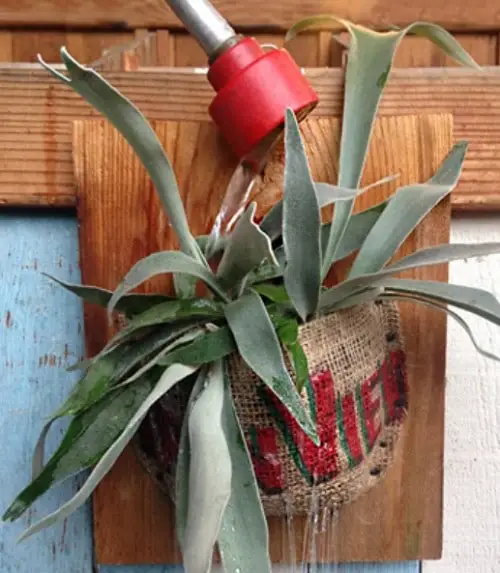Staghorn Fern Care is easy if you are aware of all the requirements. Read everything in detail to grow this beautiful plant easily in your home and garden.

With deep green flat leaves, the Platycerium bifurcatum makes for a great looking houseplant that’s also quite easy to grow. Here’s all you need to know about Staghorn Fern Care.
Here are the best ferns you can grow for containers
Staghorn Fern
The staghorn fern (Platycerium genus) is a beautiful looking plant. It was previously considered difficult to grow, but now it is quite popular.
They have two different leaves (fronds) types–sterile shield fronds that are rounded in outline, and fertile fronds, which are branched like the horns of a reindeer.
Platycerium Staghorn Fern Species

Also known as elkhorn ferns, they include 18 species that are easy to grow. The leaves come in a range of sizes and shapes; the fertile fronds can reach up to 2-3 feet in length.
- Platycerium bifurcatum
- Platycerium andinum
- Platycerium coronarium
- Platycerium alcicorne
- Platycerium elephantotis
- Platycerium ellisii
- Platycerium holttumii
- Platycerium grande
- Platycerium hillii
- Platycerium quadridichotomum
- Platycerium madagascariense
- Platycerium stemaria
- Platycerium ridleyi
- Platycerium wallichii
- Platycerium superbum
- Platycerium veitchii
- Platycerium willinkii
- Platycerium wandae
How to Grow Staghorn Fern

Propagation
You can propagate staghorn fern by side shoots or spores. Small ‘chunks’ that have a leaf and a bit of root ball can be potted separately, and large ferns can be divided into small plants. The simplest method is growing from the side shoots.
1. Growing from Division, Side shoots, or ‘Pups’
The pups develop from the base of the mother plant. You can take them out individually and plant them in pots filled with peat moss. Large pups can be grown in a wooden plaque or in a basket of sphagnum moss.
2. Growing from Spores
Ferns do not propagate from seeds and do not flower. They grow from spores, which look like patches of brown color under the leaves. Scrape them gently using a knife and sow them in a pot filled with peat moss or moist sterile potting soil. Press them gently and cover the pot or growing tray with a piece of glass and place it in a dark area with a temperature around 50-78 F (10-26 C).
Requirements for Growing Staghorn Ferns

Light
Staghorn ferns prefer bright, indirect light. If kept well-watered in a warm, humid place, they can withstand more sunlight. Just make sure that the plant is not exposed to the direct, harsh sun.
Soil
The plant actually doesn’t need soil as the fronds absorb all the nutrients. You’ll need soil just to anchor the roots and you can use a well-draining starter mix for this purpose.
Water
The best way to water the plant is to mist it gently daily, especially in the summer months. You can also dip the plant in a bathtub for 10-15 minutes, and let the excess water drip out. Once done, put it back to place.
Temperature
During winter, do not expose the ferns to a temperature below 55 F.
Humidity
Grow plants in an area with high humidity and good air circulation. Also, avoid misting the plant for maintaining humidity.
Staghorn Fern Care

Fertilizer
Feed the plant with a balanced, water-soluble fertilizer to promote active growth in summer. You can also place banana peels under the fronds for lush growth!
Pests and Diseases
Staghorn ferns can be affected by aphids and scale insects that can be handpicked or washed away with a strong jet of water. Droopy leaves indicate lack of water.
Pruning
They don’t need pruning or grooming, but you can remove old and withered ‘fertile’ leaves. Also, remove sheath-shaped ‘sterile’ leaves.
Repotting
Repotting is only needed when the plant outgrows the container or basket. Gently remove staghorn from its pot and move it to the new container. Cover the roots completely except stems and fronds with a starter mix.



How do you remove the staghorn from the basket, if it has grown around the basket it is growing in?